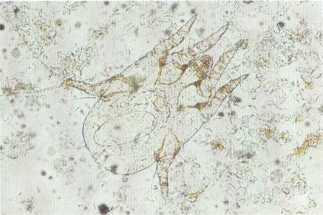35 (267)

|
A Practical Guide to Feline Dermatology |
1 | |
|
3 |
Table 3:1: Identification of the principal mites involved in feline skin diseases.
(Techniąues diagnostiques en dermatologie des camivores, Bourdeau P.
(editor Guaguere E.) pp 43-58 (PMCAC Editions, Paris 1991)
3.6

Figurę 3: a: Notoedres cati (adult) (x400) (courtesy of P. Bourdeau)
Cat (very rare), dog (extremely rare). Found in the epidermis.
Roundish shape 200-240 mm.
Short rostrum (square) - very short legs with suckers on long pedicels. Dorsal anus.
Dorsally, 4-6 pairs of thick bristles; concentric cuticular ridges, rounded scales arranged transversely.

Figurę 3 : b: Sarcoptes scabiei var. canis (adult) (x400)
Cat (extremely rare), dog. Found in the epidermis.
Oval-shaped 300-500 mm
Short rostrum (square) - very short legs with suckers on long pedicels (legs 1 and 2 in the małe and legs 1,2 and 4 in the female)
Terminal anus.
Dorsally: 1 shield, 3 + 7 pairs of spiny bristles shaped like carpet tacks; Triangular scales arranged transversely

Figurę 3 : c: Otodectes cynotis (copulating males and nymphs) (x40)

Figurę 3 : d: Otodectes cynotis (adult female) x 100
Cat and dog (very common). Found in the ear canal (rarely on the skin surface).
Oval-shaped 450-630 mm.
Short rostrum (pointed) - long legs with subsessile suckers.
Males have poorly developed abdominal lobes with filiform bristles. Females (often egg bearing) have a fourth pair of short legs (females appear to have only 3 pairs of legs); males and nymphs frequently seen joined together
Eggs sometimes seen alone (elongated ovoid shape containing the larva on which can the pointed rostrum and long legs can already be madę out).
Wyszukiwarka
Podobne podstrony:
48 (209) 4 A Practical Guide to Feline Dermatology Table 4:1: Type of hair invasion, fruiting bodies
22 (503) A Practical Guide to Feline Dermatology ■ 2 Table 2:1: Breed predispositions to common d
232 (24) 23 A Practical Guide to Feline Dermatology Table 23 : 1 : Aetiology of facial dermatosesINF
222 (33) 22 A Practical Guide to Feline Dermatology AnimaTs way of life and environment: cats that l
31 (328) 3 A Practical Guide to Feline Dermatology Sarcoptic mange Sarcoptes scabiei var canis (Tabl
58 (148) 5 A Practical Guide to Feline Dermatology severity of the illness. High titres are seen wit
65 (127) 6 A Practical Guide to Feline Dermatology Other topical antimicrobial agents, such as chlor
67 (125) 6 A Practical Guide to Feline DermatologyNocardiosisAetiopathogenesis Nocardiosis is a very
69 (119) 6 A Practical Guide to Feline DermatologyDiagnosis The diagnosis is based on lesion distrib
710 (2) 7 A Practical Guide to Feline DermatologyHerpesvirus infections Dermatological manifestation
74 (105) 7 A Practical Guide to Feline Dermatology ulcerated. Lesion distribution is multicentric bu
27 A Practical Guide to Feline Dermatology Perianal glands 1.7 Permethrin 3.12, 3.13 Persian 1.6,2.2
27 A Practical Guide to Feline Dermatology Stemphyllium spp. 5.1,7.8 Stereotypie behaviour 17.1,
272 (16) 27 A Practical Guide to Feline Dermatology Alternaria spp. 5.1,7.8 Aluminium hyroxide 15.6&
274 (18) 27 A Practical Guide to Feline Dermatology Colitis 11.2 Collagen 1.2,2.6,12.1,
278 (17) 27 A Practical Guide to Feline Dermatology I J Histoplasmosis 5.8, 7.8, 25.2 Homer’s syndro
28 (374) 2 A Practical Guide to Feline Dermatology Configuration of lesions Determining the configur
313 (14) A Practical Guide to Feline Dermatology The second phase consists of long-term control of t
82 (128) 8 A Practical Guide to Feline Dermatology considered important parasites. Cats in the Unite
więcej podobnych podstron